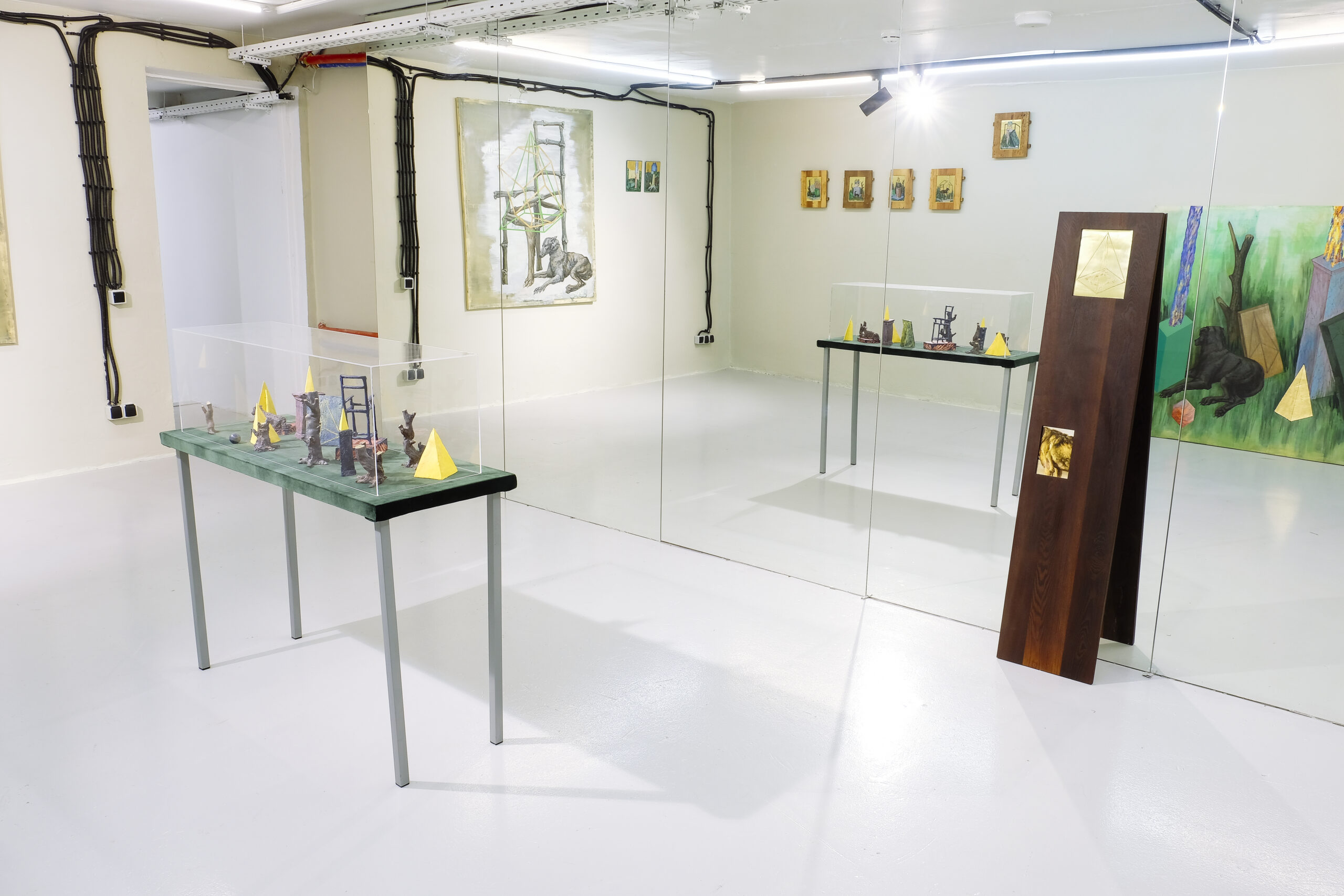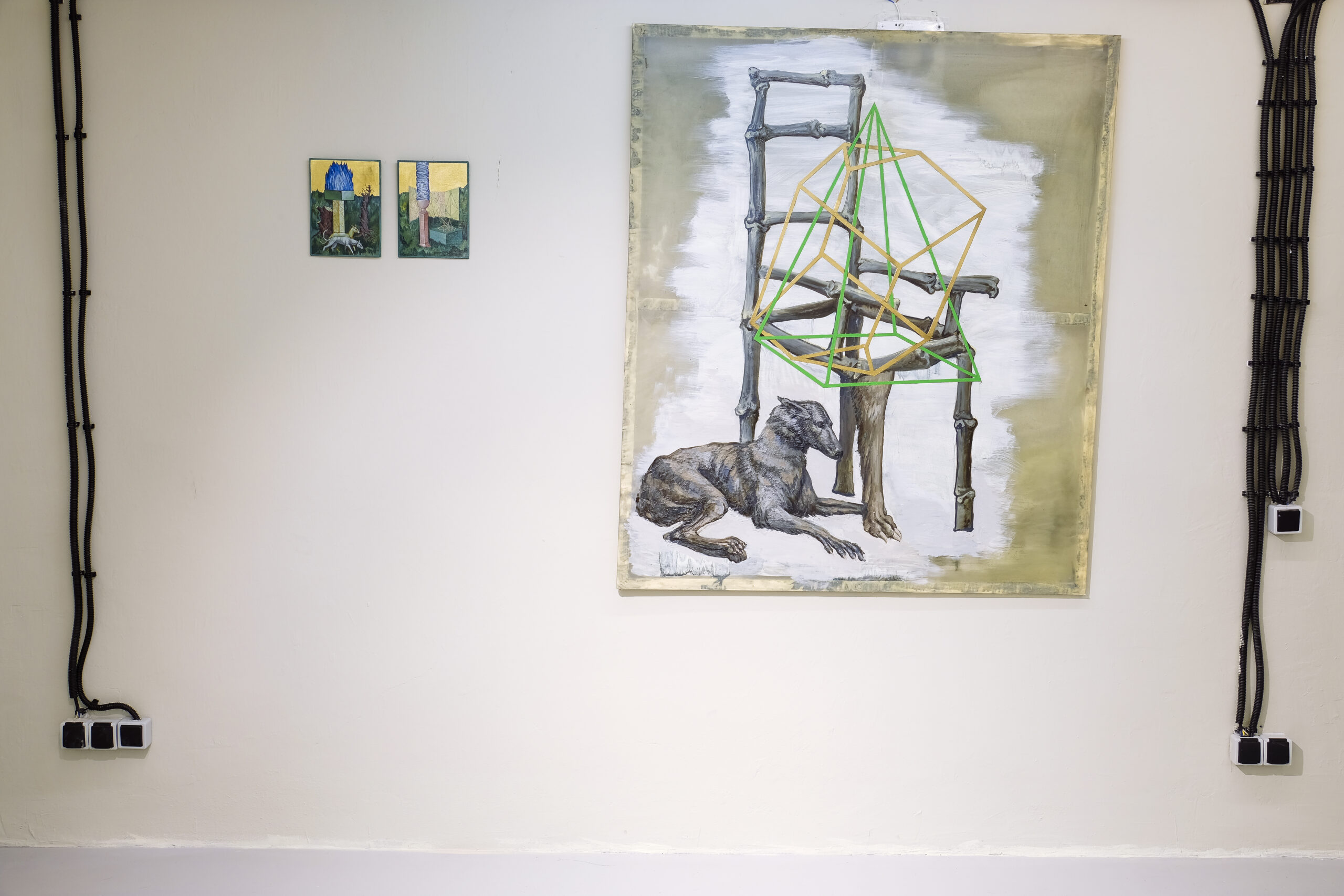 Back to Exhibitions
Back to Exhibitions
























“The Disappearance of Man at the end of History will not be a cosmic catastrophe: the natural World will remain as it used to be for ages. And even more so it will not be a biological catastrophe: the Man continues to live, but as an animal, in accordance with Nature or present Being. The one who disappears is the Man himself, that is, the denying present Action and Error, or the Subject in general opposing the Object. Indeed, the end of human Time, or History, that is, the final abolition of the Human being as is or of the free historical Individual, simply means the cease of Action in the literal sense of the word. What practically means: the disappearance of wars and bloody revolutions. And also the disappearance of Philosophy, for if a Man does not change any more in his essence, then there is no reason to change the basis (genuine), on which his knowledge of the World and himself is built. But everything else can remain indefinitely long: art, love, play, etc .; in short, everything that makes a Human happy.”
When reading this footnote by Kozhev to the Hegel’s seminar from 1938-39, it is appropriate to ask yourself: what is this list of practices (some kind of pastoral picture) that remain after the human qualities disappear in a human being? Art, love, play – are they free from the negativity of praxis? Do they make the Man happy by relieving him of the burden of “acting”? But if Hegel was “flipped from head to feet,” then the same procedure is valid in regards to the comments on Hegel. Kozhev raises the question of the end of history. Like prehistoric, posthistorical time – this is the territory of ideology, a place where imaginary ideas settle, legitimizing the power of the historical notion itself (class contradictions).
Artists know better than others that art will never bring “happiness”, because they interact with it as with alienated labor in the capitalist system, whereas the viewer is free from this historicity of art and can perceive it as a product or commodity that promises the illusion of happiness. To be a modernist artist, starting from Manet and Courbet, means to exhibit not so much the products and goods (approach art from the viewer’s side), but the very logic of the alienation of artistic labor in the form of an art work. What does it mean – “in the form of an art work”? What is an art work ideologically? An art work is something that overcomes the history of its creation. In the text “Art and objectivity” Michael Fried says that painting has a pictorial form that overcomes and defeats the objectiveity of the canvas, thereby distinguishing it from other , everyday and utilitarian things. The art work, therefore, is the removal of the contradictions of commodity production, the end of the history of labor in the microcosm of the canvas. But if we say that a modernist artist exposes the very logic of the alienation of artistic labor in the form of a work, then this can only mean one thing: the work plays the end of history as if it happened in the world of unsolved contradictions.
Courbet’s stone breakers will be working forever, working in eternity. Henry Wallis, in his interpretation of a similar plot, depicts a breaker who takes a rest after hard work. But if we look closely, we will see that he is dead. He is given to the viewer in the art work being dead forever. In the field of art of the XIX century, a work of art is presented from two sides – from the artist, who understanding art as work, sees the work of others, and from the viewer, who sees art as leisure. Depending on which side of the controversy we are on, we interpret this work as either rest or death from unbearably hard work. Wait a minute! But isn’t according to capitalism leisure itself is a small death after work day is over? Imagine now the phrase by Kozhev in a situation where after the end of history the art of Wallis and Courbet is all that remains.
In 1961, Robert Morris made the “Box with the Sound of Its Own Making”. In a minimalist volume, he put an audio recording of how this cube was made. From Courbet, Manet, and Wallis to Morris and his box of sounds, we can draw the history of modernism as grasping the contradiction between work and leisure, art as release, and art as production. But if we analyze these works from the point of view of ideology, then they, focusing on the convention of the work, bypass the convention of the system as a whole. In other words, modernism understands an art work as a cult, and not as a theology. As a post-religious practice, but not as a system of concepts that govern this practice. In the 60s, when the idea of “the world of art” or “the system of art” appears, we can talk about the transition from cult to theology.
The relationship between cult, theology and art interests me in relation to Anton Kushaev. Already at his debut solo exhibition at the “Start” space he presented the combinatorial system of connecting bones. In the most diverse media, in pseudo-architectural motifs, connections and articulations were persistently repeated. But his combinatorics and arithmetic was not abstract and refined, as, say, in the works of Sol LeWitt. It clearly pointed to the ritual character, but this ritual was absolutely empty. This is how one can interpret the relationship of “contemporary art” (I take this term in quotes, referring to its concreteness and specificity, and not just chronological character) to classical conceptualism and minimalism, especially in Russia, where these methods tend to be perceived in an alienated form. When we perceive these methods as something distant, they appear to a young artist as something like a strange tautological dogma.
When a young artist in Russia falls into the sphere of labor relations in the field of art, he experiences these contradictions vividly. After the project at the “Start” space Anton Kushaev participates in the Winzavod’s Open Studios, where the artistic process shifts from the product to the production itself and his exploration in this direction is significant and can clarify a lot about his art. In his relationship to an art work, a contradiction is played out between the alienated methods of contemporary art, reducing the legacy of minimalism and conceptualism to the form of an empty ritual and an attempt to give us an imaginary idea of this alienation itself. I repeat: this alienation is no longer taking place at the convention level of the work (modernism), but at the level of art as a system. This alienation at the level of the system, and not of the commodity, was best captured by the main theoretician of ideology Louis Althusser in his text on the painting of Cremonini. He emphasizes that the painting of this artist draws attention not to things, but to the connections between things where the human is missing. According to Althusser, Cremonini explores how things subordinate their people to themselves and a person in this painting is given negatively, like the absence inside of the relationship of things themselves. In this text, it is important that Marxism, after the 60s, places special emphasis on systems. For example, commodity fetishism should not base itself on the interpretation of the merchandise as a single thing, but on the interpretation of the entire system as a whole (this tradition was summarized by Zizek in the “Sublime Object of Ideology”). Thus, Cremonini depicts the absence of a man in the systems of things. I think it is important in relation to this exhibition of Anton Kushaev as well. But if Cremonini’s place of disappearance is everyday life, then Kushaev subtracts a man from the system of art and its tradition. He creates a figure of modern alienated artistic labour, where icon painting tradition, minimalism, the history of abstract painting turn out to be a stage of disappearance. He is interested not in everyday life, but in the representations themselves, the ritual ones that are empty. Conceptual art describes everyday life as a language, turning things into words in a coherent statement on the territory of artistic spaces. But in today’s context, this language itself, or multiple languages, are alienated and perceived as an empty form of spells and dogmas. This is the expression of “fetishism of systems” and “fetishism of the languages of art”. It seems to me that this is why a dog is an important figure here. The dog is the border on which the animal becomes a commodity or even part of the interior in the capitalist worlds. The Kushaev’s dog is not the Kulik’s dog. It is a vivacious everyday life that, in the bourgeois way of life, reminds the landlord of his own silence and the loss of the meaning of any language – turning it into a ritual. Now it is clear: we do not own our pets, but they own us – we are humans of our pets.
In a picturesque respect, Kushaev is interested in a green background – as the most concrete abstract background on which visual digital effects are created. This green background is the place of a language that has become a ritual. It is farthest from the color of human skin to fit the actor on the post-cinema scene.
1) There is a certain continuity for Althusser between Cremonini, Francis Bacon and this exhibition. All of them depict the place of the disappearance of a human as a place of his alienation on the stage (how the space is divided into plans in the whole tradition of painting);
2) This continuity indicates that the contradiction between labor and leisure in art is moving away from the convention of an art work (as was given by early modernists like Manet and Courbet) to the convention of language and structure;
3) This artist’s presentation of the very alienation in work should be related to the local specificity of the art world in Russia, where historical forms of conceptualism and minimalism, but also the theory of art itself, are already given as a commodity, not from the point of view of production and reproduction, but from the point of view of consumption.
But back to Kozhev. If the end of history reveals the animal side in a man, Anton Kushaev creates a different theology for us. Imagine that we find ourselves being placed in paradise for good, after the history, where all the animals are “domestic”, where they are all alienated from themselves and, as in a crooked mirror, show our own loss, our bright, staged disappearance on the art scene. Can such art become happiness? Does Anton Kushaev give us peace in the icons of another world? Not at all. Artists know better than others that the paradise, which the viewer ascribes to art to depict, precisely because of the existence of the art as labour – is even darker than happiness. Happiness???
Boris Klushnikov